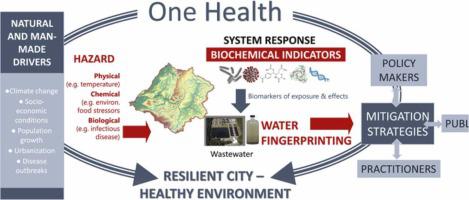Journal of Hazardous Materials ( IF 13.6 ) Pub Date : 2021-11-25 , DOI: 10.1016/j.jhazmat.2021.127882 Barbara Kasprzyk-Hordern 1 , Kathryn Proctor 1 , Kishore Jagadeesan 1 , Felicity Edler 1 , Richard Standerwick 2 , Ruth Barden 3

|
This paper tests the hypothesis that human population and city function are key drivers of biochemical burden in an inter-city system, which can be used to inform One Health actions as it enables a holistic understanding of city’s metabolism encompassing all of the activities of a city in a single model: from lifestyle choices, through to health status and exposure to harmful chemicals as well as effectiveness of implemented management strategies. Chemical mining of wastewater for bipchemical indicators (BCIs) was undertaken to understand speciation of BCIs in the context of geographical as well as community-wide socioeconomic factors. Spatiotemporal variabilities in chemical and biological target groups in the studied inter-city system were observed. A linear relationship (R2 >0.99) and a strong positive correlation between most BCIs and population size (r >0.998, p <0.001) were observed which provides a strong evidence for the population size as a driver of BCI burden. BCI groups that are strongly correlated with population size and are intrinsic to humans’ function include mostly high usage pharmaceuticals that are linked with long term non-communicable conditions (NSAIDs, analgesics, cardiovascular, mental health and antiepileptics) and lifestyle chemicals. These BCIs can be used as population size markers. BCIs groups that are produced as a result of a specific city’s function (e.g. industry presence and occupational exposure or agriculture) and as such are not correlated with population size include: pesticides, PCPs and industrial chemicals. These BCIs can be used to assess city’s function, such as occupational exposure, environmental or food exposure, and as a proxy of community-wide health. This study confirmed a strong positive correlation between antibiotics (ABs), population size and antibiotic resistance genes (ARGs). This confirms the population size and AB usage as the main driver of AB and ARG levels and provides an opportunity for interventions aimed at the reduction of AB usage to reduce AMR. Holistic evaluation of biophysicochemical fingerprints (BCI burden) of the environment and data triangulation with socioeconomic fingerprints (indices) of tested communities are required to fully embrace One Health concept.
中文翻译:

人口是城市间系统中生化负担的主要驱动力:对 One Health 概念的影响
本文检验了以下假设:人口和城市功能是城市间系统中生化负担的关键驱动因素,可用于为 One Health 行动提供信息,因为它可以全面了解城市的新陈代谢,包括城市的所有活动在单一模型中:从生活方式的选择,到健康状况和接触有害化学物质,以及实施的管理策略的有效性。对废水进行化学挖掘以获取双化学指标 (BCI),以了解地理和社区范围内的社会经济因素背景下 BCI 的物种形成。观察到所研究的城际系统中化学和生物目标群体的时空变化。线性关系(R 2>0.99) 并且大多数 BCI 与人口规模之间存在强正相关 (r >0.998, p <0.001),这为人口规模作为 BCI 负担的驱动因素提供了强有力的证据。与人口规模密切相关且与人类功能密切相关的 BCI 组主要包括与长期非传染性疾病(非甾体抗炎药、镇痛药、心血管、心理健康和抗癫痫药)和生活方式化学品有关的高使用率药物。这些 BCI 可用作人口规模标记。由于特定城市的功能(例如工业存在和职业暴露或农业)而产生的与人口规模无关的 BCI 组包括:杀虫剂、PCP 和工业化学品。这些 BCI 可用于评估城市的功能,例如职业暴露、环境或食物暴露,以及作为全社区健康的代表。这项研究证实了抗生素(ABs)、种群规模和抗生素抗性基因(ARGs)之间的强正相关。这证实了人口规模和 AB 使用是 AB 和 ARG 水平的主要驱动因素,并为旨在减少 AB 使用以降低 AMR 的干预措施提供了机会。需要对环境的生物物理化学指纹(BCI 负担)进行整体评估,并与测试社区的社会经济指纹(指数)进行数据三角测量,以完全接受 One Health 概念。种群大小和抗生素抗性基因(ARGs)。这证实了人口规模和 AB 使用是 AB 和 ARG 水平的主要驱动因素,并为旨在减少 AB 使用以降低 AMR 的干预措施提供了机会。需要对环境的生物物理化学指纹(BCI 负担)进行整体评估,并与测试社区的社会经济指纹(指数)进行数据三角测量,以完全接受 One Health 概念。种群大小和抗生素抗性基因(ARGs)。这证实了人口规模和 AB 使用是 AB 和 ARG 水平的主要驱动因素,并为旨在减少 AB 使用以降低 AMR 的干预措施提供了机会。需要对环境的生物物理化学指纹(BCI 负担)进行整体评估,并与测试社区的社会经济指纹(指数)进行数据三角测量,以完全接受 One Health 概念。



























 京公网安备 11010802027423号
京公网安备 11010802027423号